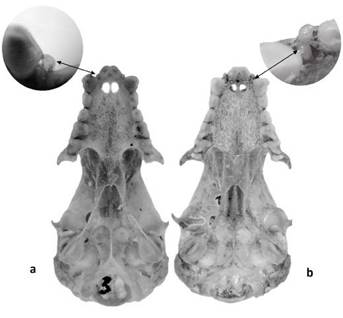Introduction
Systematics and taxonomy of bats is based in part on the morphological characteristics of teeth and dental formulas (Ramírez-Pulido and Müdespacher 1987; Rui and Drehmer 2004; Lanza et al. 2008; Cirranello et al. 2016). Abnormal dental formulas occur infrequently in natural populations of bats. However, when supernumerary teeth are present, the attendant changes in the shape and number of teeth can sometimes lead to erroneous taxonomic identifications.
There are mainly two types of anomalies in the number of teeth in mammals: polyodontia and oligodontia (López-Aguirre 2014). The first anomaly is rarer than the second (Lanza et al. 2008). Polyodontia, also called hyperdontia, hyperdoncia, third set of teeth, extra teeth, or polidontismo (Rodriguez and Cerviño 2009) can be caused by: 1) the creation and subsequent development of an additional tooth germ caused by expressions of rare genes. 2) The complete division of a tooth germ caused by mutations or changes in the genetic control of the development of teeth (Wolsan 1984). 3) By isolated mutations that could cause abnormalities to proteins such as Sonic hedgehog (Shh) that are responsible for normal development of molars and incisors, resulting in abnormal locations and stunted growth of these teeth (Dassule et al. 2000).
Numerous cases of dental anomalies have been reported for many groups of mammals, such as felids (Lynx lynx; Gomerčić et al. 2009), marsupials (Dromiciops gliroides, Rhyncholestes raphanurus; Martin 2007), cervids (Cervus elaphus hispanicus; Azorit et al. 2002), rodents (Hystrix cristata, Necromys lasiurus; Angelici and Luiselli 1999; Libardi and Percequillo 2014), pinnipeds (Arctocephalus australis, A. tropicalis, Otaria flavescens; Loch et al. 2010) and bats (Artibeus lituratus, Epo-mophorus wahlbergi; Rui and Drehmer 2004; Lanza et al. 2008) among others.
Bats are the group with most dental anomalies among mammals. López-Aguirre (2014) recorded 64 species of bats with dental anomalies, which predominate in insectivorous species, especially those belonging to the genus Myotis. The same author mentions that in the family Phyllostomidae, twenty-two species with dental anomalies have been reported, followed by Vespertilionidae and Pteropodidae with 18 and 17 species, respectively. This note presents a rare case of bilateral hyperdontia in Carollia brevicauda, a species whose characteristic dental formula (I 2/2, C 1/1, PM 2/2, M 3/3) is affected here in the normal number of incisors.
Material and methods
The specimen of Carollia brevicauda was collected during a study in the piedmont plains on the bat assembly of species present in the middle basin of the Rio Guayuriba, Acacias - Meta, Colombia. The catch was made in March 2014, in the village Portachuelos (4.18090° N, -73.80998° W) at 1,708 m elevation using mist nets set in a patch of tropical moist forest. Additionally, 25 bat species were recorded with Carollia being the most abundant genus with 197 captures. C. brevicauda was recorded on 66 occasions with 23 being collected, only one of which having the described dental anomaly. This individual was deposited in the Collection of Mammals of the Natural History Museum of the Francisco José de Caldas University (MHNUD) under catalog number 921.
Results
The aberrant individual has an additional incisor adjacent to each normal external incisor in the maxilla, with separate alveoli, for a total of six upper incisors, two more than normal (Figure 1). It is an adult male, and thus has a degree of cranial sutures with an advanced degree of ossification, and little wear on tooth cusps. However, the evidence from the following morphometric measurements (in mm) is sufficient to determine that it is an adult (Morris 1972): total length (TL): 64.0, wingspan (W): 309.0, forearm length (FA): 39.2, ear length (E): 18.6, noseleaf (N): 8.0, foot length (FL): 9.8, tibia: 13.0, calcaneus: 4.6 and body weight 18.6 g.
Discussion and conclusions
This is the first record of bilateral hyperdontia for this species. Previously, only cases of oligodontia had been reported for Carollia brevicauda (López-Aguirre 2014). The extra numerary teeth have a morphology similar to the external incisors characteristic of the species, short and rounded (Figure 1a) and are located between the canine and the second upper incisor (external) on each side of the upper jaw (Figure 1b).
This dental anomaly may be due to an isolated mutation present in this one individual, and without a permanent presence in the population since no other specimens with this type of anomaly were found in the study area. More likely, this is an example of the reappearance of an ancestral trait (atavism) caused by a shift in developmental patterning.











 nueva página del texto (beta)
nueva página del texto (beta)



